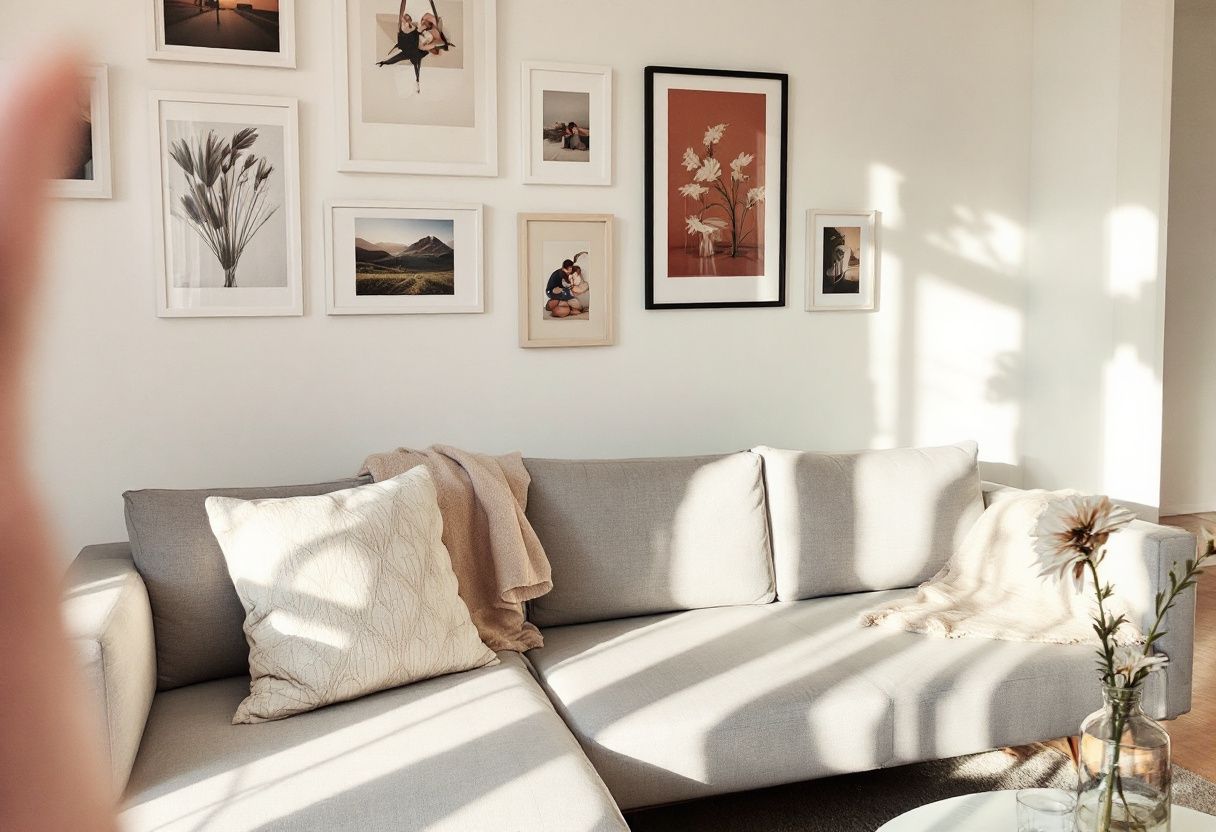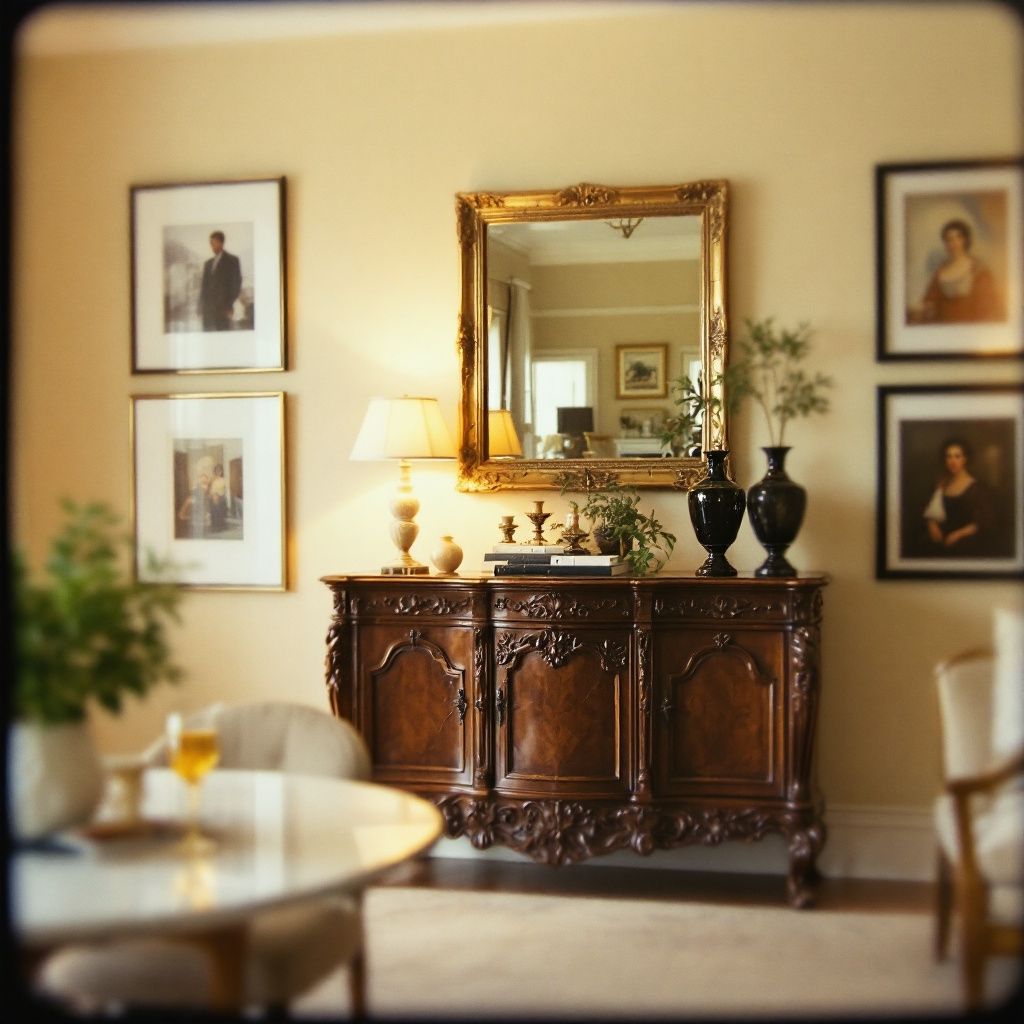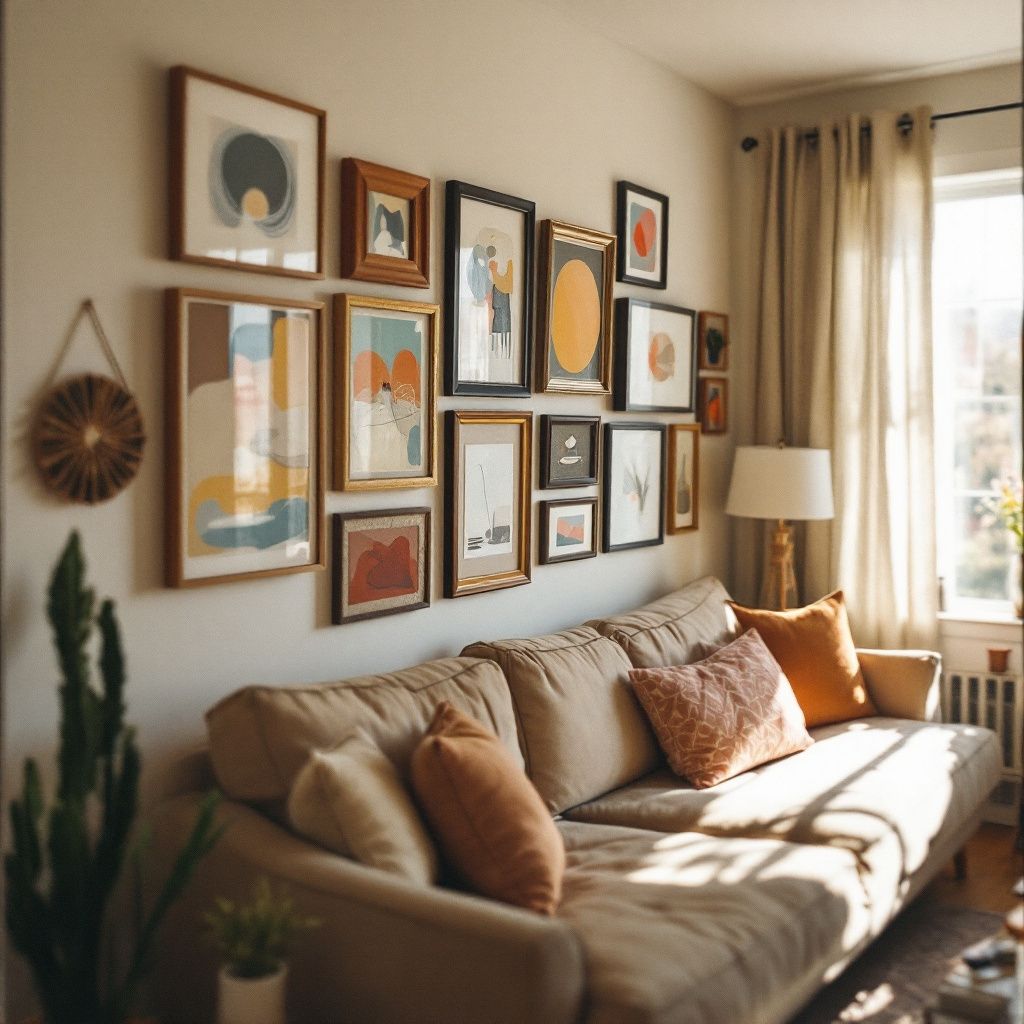
The Importance of Coordinating Furniture and Frames
The relationship between furniture and frames is as crucial as any other element in a room. Framed art or photographs offer not just a window into your personal taste but also act as a bridge connecting various design elements. On one hand, misaligned styles can make your space feel disorganized or overwhelming. But when you strike the right balance, it adds an extra layer of polish and sophistication.
One practical way to ensure this harmony is through framing choices that complement your existing furniture's character, style, and color palette. For instance, if you’ve designed a room around clean, minimalist principles, opting for a sleek, monochrome frame style ensures the walls and decor serve to enhance, rather than complicate, the overall composition.
On the other hand, not considering the visual relationship between furnishings and wall decor can result in a jarring, cluttered atmosphere that undermines your interior aesthetic. Frames shouldn't compete with or overpower the rest of your furnishings; rather, they should integrate seamlessly with other design elements, providing cohesion without overshadowing either the art or the furniture.
At Text To Frame It, we make it easy to find the right coordination. Whether you prefer modern, minimalist frame choices or prefer something with more texture to match a rustic setting, we've got sustainable options to suit your taste—all just a quick text away!
Frame Selection Based on Furniture Style
Different furniture styles call for different framing techniques. Let’s break it down by popular interior styles and the types of frames that work best with them.
1. Modern or Minimalist Furniture Designs
Minimalist spaces call for unpretentious, sleek frames. Think clean lines and frames that are thin or made of raw, unadulterated metallic materials (black, silver, and white frames work best). When choosing frames for minimalist spaces:
- Stick to monochromatic tones for a seamless transition between furniture and frames.
- Avoid anything too decorative or ornamental as it may distract from the serenity of the furniture's design.
- Consider thin frames or even frameless pieces for a gallery-like effect.
2. Rustic Furniture
Rustic furniture often calls for organic, natural materials. Think about coordinating frames that bring out the earthiness of your decor. Ideal frame choices might include wood textures, distressed finishes, or even pieces that have a weathered look.
- Frame materials such as reclaimed wood or bamboo can amplify the rustic feel.
- Dark, matte frames in earthy tones like deep browns or black work well to contrast softer, textural furniture.
- Opt for natural wood finishes to create a continuous flow in your room's look.
3. Contemporary Furniture
With contemporary furniture, you may want to balance it out with equally bold yet simple frame designs. Large mats and oversized frames often shine in this setting by providing contrast and allowing the artwork to breathe around sleek furniture.
- Oversized frames introduce a contemporary vibe.
- Opt for modern glass or matte finishes to keep things polished but playful.
- Choose a frame color that resonates with accent colors in the room for cohesion.
4. Eclectic or Bohemian Experimentation
These spaces allow for a lot of layer mixing—textures, patterns, and colors. You could combine mismatched frames that still work together for consistent visual interest, or opt for one anchor frame that draws the eye.
- Mix and match frame materials and textures for a more curated, lived-in effect.
- Don’t be afraid of bold colors—go with bright or metallic frames to catch the eye.
- Incorporate artisan-made and hand-crafted frames to align with Bohemian characteristics.
Color Coordination between Frames and Furniture
One of the most straightforward ways to create harmony is through color coordination. The color of your furniture or its accents should be a guide when selecting frame borders. Here’s how to pair colors effectively:
1. Neutral Furniture
Neutral furniture provides a great base for dynamic framing decisions. You can go two ways:
-
If you prefer sophistication, opt for neutral frames like black, gray, or beige.
-
If you like a pop of contrast, introduce bolder frame colors against neutral furniture. Choose contrasting tones that can pull focus, tying your artwork into the room while maintaining softness.
2. Bold, Colorful Furniture
Suppose your furniture includes bold, eclectic colors. Use neutral or black frames to tone it down, or introduce complementary colors that are echoed in accents elsewhere.
-
Pair a colorful couch or chairs with black and white framed photos. This framing choice balances vibrancy and creates a classy yet cohesive look.
-
Alternatively, choose abstract artwork with complementary hues for a seamless visual dialogue that supports the overall aesthetic of your furniture.
Consider Frame Size in Relation to Furniture
Choosing the correct size of a frame in relation to your furniture is key to good proportionate design. Follow these steps to make sure the sizing feels right:
1. Over Couch or Sofas
When hanging framed art above a sofa, aim for the frame to be neither too overpowering nor too understated. A good rule of thumb is to choose a frame that spans about ⅔ to ¾ the width of the couch. This creates a balanced focal point above the furniture without overwhelming the room’s scale.
- For awkwardly shaped walls or larger spaces, consider grouping multiple smaller frames together to form a gallery-style arrangement.
2. Above Sideboards or Consoles
Sideboards and consoles provide excellent opportunities for framed art. Ideally, choose a frame or a group of frames that complements the horizontal nature of the furniture below. This means framing artwork that spans the length of the console or slightly shorter offers a cohesive look.
- Arrange 2-4 smaller frames in sequence to achieve horizontal harmony.
- Ensure the framed arrangements align with or slightly mirror the furniture's width to balance out the visual weight.
3. In Corners or Compact Spaces
When working with small corners or compact spots like reading nooks, oversized frames may feel too cumbersome. Instead, opting for smaller frames or an asymmetric cluster of pieces can bring life to these overlooked areas without diminishing their coziness.
- Stick with intricately arranged smaller frames or custom-sized pieces to keep the area feeling proportional.
- Using small gallery walls in compact spaces helps bring charm without cluttering the visual flow.

Style Coordination: Combining Traditional and Modern Elements
Trying to blend traditional furniture with modern frames, or vice versa, is not only possible but can also make your space even more compelling. Striking a balance between these diverse styles is key to achieving the right contrast rather than creating visual dissonance.
1. Traditional Furniture with Modern Frames
Picture rich, antique wooden furniture paired with sleek, thin modern frames. This combination can create a deliberate contrast that elevates both the frame and the furniture. The simplicity of a thin frame puts the focus on the artwork, offering a breath of fresh air amid heavier, ornate surroundings.
However, ensure the colors of the frame complement the tones in the furniture to maintain cohesion. For example, black or metallic modern frames pair well with dark wood furnishings. Just avoid going too far with ornate furnishings and highly simplistic frames, as this can sometimes feel disjointed.
2. Modern Furniture with Traditional Frames
On the flip side, if you have minimalist or contemporary furniture and want to add texture and a touch of luxury, go for more traditional framing options. Choosing a frame with intricate wood carvings or painted flourishes can infuse a sense of elegance without overpowering your modern interior's sleek lines. The key here is scale – ornate frames in small doses work well on large, airy walls, especially when used sparingly so as not to overshadow the simplicity of modern furniture.
In either scenario, one element should play the dominant role while the other subtly complements it. For instance, if your antique buffet is the room's focal point, let the sleek frame take a backseat, or when your minimalist table should sing, an intricate frame becomes its equally elegant but quieter partner.
Gallery Walls and Statement Sets
For larger spaces or when you have a collection of photos, a gallery wall is a fantastic way to add interest. A gallery wall allows you to showcase multiple pieces while still maintaining a harmonious style by choosing consistent frames, layouts, and spacing.
1. Before You Begin: Plan Layout and Spacing
Carefully plan the size and layout of your gallery wall. Determine the amount of wall space vs. the size of the furniture it’s meant to complement. A misaligned gallery wall can easily overpower a room or, conversely, feel too sparse if spread too thin. Here are a few layout options to consider:
- Symmetrically aligned pieces: A grid-style or symmetrical alignment tends to provide a structured, professional appearance. This works especially well when paired with highly structured furniture sets, like formal living room seating arrangements.
- Freeform layouts: For cozy or eclectic furniture setups, consider a more relaxed, asymmetrical layout for your gallery wall. This organic flow accommodates different-sized frames and adds a sense of whimsy or personalized flair.
Ensure that there's enough space between frames, but not so much that they feel disconnected from one another. The key is to balance the negative space with clustered frames that still breathe.
2. Frame Consistency
Another important factor in a well-executed gallery wall is frame consistency. While it's tempting to go wild with various frame types and colors, it’s best to stick to some uniformity to maintain a cohesive look across the entire display. Avoid overcomplicating the wall with too much variety.
- Black or wooden frames: Sticking to one material such as black or wooden frames is a standard choice and works exceptionally well for tying a modern gallery wall beside contemporary furniture.
- Mixed textures and three-dimensional elements: For extra depth, you can integrate a couple of mirrors, metal sculptures, or other three-dimensional pieces among your framed artwork. Done sparingly, this can add more character without distracting from the framework.
Ultimately, a good gallery wall reflects your unique style while staying balanced with both wall size and the furniture it accompanies. If you're looking to make your own gallery wall standout, we at Text To Frame It can help you turn your favorite digital images into professionally framed pieces—just text us your pics, and let us do the rest! It only takes a quick minute, and the results will be nothing short of stunning.

Quick Tips for Different Room Types
1. Living Room
The living room offers room for creativity and boldness. Whether you're centering frames above the sofa or spreading a mix of gallery frames across entire walls, this space can handle variety without feeling overdone. Opt for larger frame sizes or focal pieces to anchor the room, and consider combining different styles within a gallery wall to add dynamic interest.
2. Bedroom
In the bedroom, the goal is intimacy and relaxation. The frames you choose should reflect that atmosphere, making family photos, serene landscapes, or calming abstract artwork ideal picks. Pair softer tones found in poster or framed images with modest frame styles that blend with casual or comforting furniture. This creates a peaceful sanctuary where content meets comfort.
3. Dining Room
When it comes to the dining room, it's all about enhancing the mood without overwhelming the space. Frames positioned over a dining table should be thoughtfully selected and proportioned according to the furniture. Consider anchor pieces with subtle colors and neutral frames to complement, rather than distract from, the dining experience. For a balanced yet inviting look, keep the frame-to-furniture ratio in check—especially focusing on style coordination between the two.

Creating harmony between furniture and frames adds an understated level of design sophistication to any space. Thoughtful choices—whether it’s matching colors, mixing textures, or balancing size—can bridge the gap between wall decor and furnishings, uniting everything for an overall cohesive look.
To explore custom framing options that suit your home and style, don't hesitate to check out our service where framing your best photos takes just a text and a quick minute!
With the right coordination, your home can become a visually stunning, harmonious environment that reflects your personal style perfectly.



